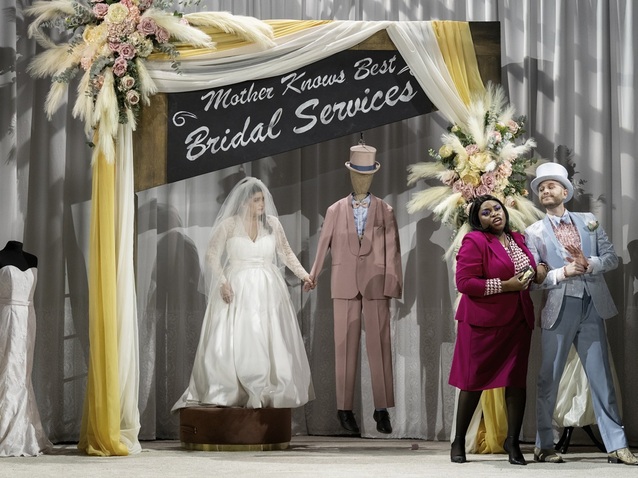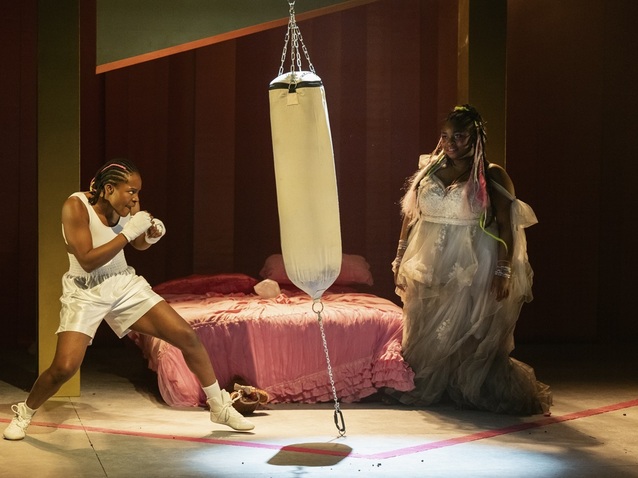 © 2024 ROH ph. Camilla Greenwell
© 2024 ROH ph. Camilla Greenwell
This Royal Opera double bill, performed by Jette Parker Artists, presents two one-act operas that were written at broadly opposite ends of the twentieth century, but received their premieres just eight years apart. Bohuslav Martinů composed Larmes de couteau, to a French libretto by Georges Ribemont-Dessaignes, in 1928, but it did not receive its premiere until 1969 at the State Theatre, Brno. The music demonstrates the composer’s then preoccupation with jazz, while the story contains Surreal and Grotesque elements. It sees a girl named Eleanora horrified to discover that her Mother has arranged for her to marry Satan! When a Hanged Man suddenly pops down, Eleanora declares that she is in love with him, and Satan conducts the marriage of Eleanora and The Hanged Man before leaving with The Mother.
Eleanora imagines a life of adventure with The Hanged Man, but feels rejected and lonely when (for obvious reasons) he shows no reaction to her advances. In despair she kills herself, but Satan tells The Mother he can revive Eleonora, provided that she helps him. Satan disguises himself as The Hanged Man and declares his love for Eleanora, who is revived. She embraces ‘The Hanged Man’ before discovering it is Satan, who then flees. The Mother laments his departure, for while she is frightened of him she does find him attractive, and Eleanora cries “I am a poor misunderstood woman!”.

Valentina Puskás (Eleanora) Veena Akama-Makia (La mère) Edmund Danon (Satan) Larmes de couteau (c) 2024 ROH ph. Camilla Greenwell
Eleanor Burke’s production in the Royal Opera House’s intimate Linbury Theatre does not so much make sense of the Surreal elements as heighten them. That is entirely appropriate, however, because when an opera is not designed to be taken literally, the worst thing one could do is sanitise it by trying to slot everything into place. In addition, the emphasis is very much on heightening the Surrealism rather than taking it to extremes, which might have risked ruining things the other way.
The irony is heightened by all of the action taking place, in Anna Reid’s set, in a wedding shop entitled ‘Mother Knows Best Bridal Services’. This leaves us wondering, if The Mother can be like this when arranging her own daughter’s wedding, what is she like when organising anyone else’s? However, the point may be that The Mother is so keen for her daughter to marry Satan that she has established an entire business to achieve this one aim.
There is an exquisite attention to detail so that the dummy of The Hanged Man is initially just one of seven hanging from the ceiling, with the fact that only the trousers and shoes of each are visible meaning they could be mistaken for menswear on display. When at one point these swing, it adds a further dimension, and it is an interesting touch for Satan and The Hanged Man to don the same outfit, only with the colours reversed so that what is pink on one suit is blue on the other.

Aisha Weise-Forbes (The Queen - Boxer) Veena Akama-Makia (The Queen) Full Moon in March (c) 2024 ROH ph. Camilla Greenwell
John Harbison described his Full Moon in March of 1977 as an ‘emblematic, ritual opera’, having adapted the text from a late symbol-laden play by W B Yeats. Set in a mythical kingdom, it sees a lowly Swineherd travel a great distance to reach the virgin Queen’s kingdom. He is determined to compete in the singing competition there so he may win her hand, but she proclaims that no suitor yet has moved her with his song, and warns him against trying as the penalty for failure is death. The Swineherd persists, and the Queen becomes intrigued by his confidence, making her think that he could be the one to help her find love and liberation. When, however, it transpires that he is primarily interested in bedding her and taking her wealth, she orders him to be executed. The Queen then feels lost, and though she is not heard from again, her desire for revenge is played out in a fantasy by a Boxer who restores the Queen’s strength.
In Harriet Taylor’s production the Queen’s bed takes centre-stage, with the ‘twist’ being that a guillotine hangs over the bottom end of it. The opera features a ‘prepared piano’, played here by Thomas Ang, which sees screws, washers or coins placed between various strings. These affect the colour or pitch of the note, and thus prove to be an important component in Harbison’s enigmatic score. The two operas are conducted extremely well by Edward Reeve, who leads the Britten Sinfonia, while the majority of cast members appear in both. This gives them the chance to show just how versatile they are, and several performances really stand out. Valentina Puskás reveals a full and engaging soprano as Eleonora before being equally persuasive as one of two Attendants in Full Moon. The other is played by Jonah Halton who displays a highly pleasing tenor and notable charisma. With her highly accomplished mezzo-soprano, Veena Akama-Makia is equally strong as the almost comical Mother and the disturbingly intriguing Queen, while Edmund Danon, with his splendid baritone, offers slick charm as Satan and something completely different as The Swineherd.
By Sam Smith
Larmes de couteau / Full Moon in March | 26 April - 4 May 2024 | Linbury Theatre, Royal Opera House, Covent Garden
the 02 of May, 2024 | Print
Comments